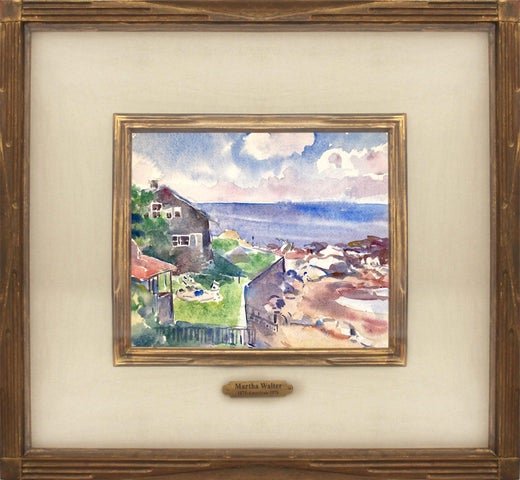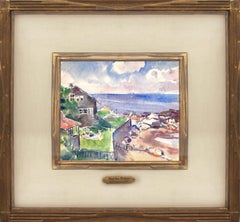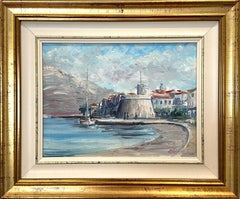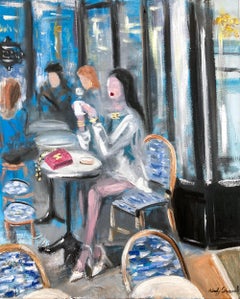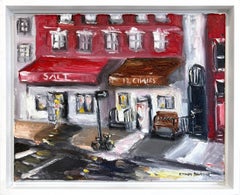Want more images or videos?
Request additional images or videos from the seller
1 of 14
Martha WalterHome Garden Scene20th Century
20th Century
Price:$4,500
$7,200List Price
About the Item
- Creator:Martha Walter (1875-1976, American)
- Creation Year:20th Century
- Dimensions:Height: 23.5 in (59.69 cm)Width: 25.75 in (65.41 cm)Depth: 1 in (2.54 cm)
- Medium:
- Movement & Style:
- Period:
- Condition:The painting is in great condition besides having a small creasing on the lower right corner in the signature area.
- Gallery Location:New York, NY
- Reference Number:Seller: 0017061stDibs: LU9821806413
Martha Walter
Walter was born in Philadelphia in 1875. She enrolled at the Pennsylvania Academy of the Fine Arts, where she studied under William Merritt Chase, who became her primary mentor. At his insistence, she entered a number of Academy student competitions and eventually won a prestigious Cresson Traveling Scholarship in 1908. This award enabled her to travel throughout Europe, where she continued her art education at the Grande Julien in Paris. Soon disenchanted with the academicism of the Parisian schools, Walter set out on her own and began producing plein-air paintings in the manner of the French Impressionists. At the outbreak of World War I, she returned to the United States and took up painting at various East coast beach resorts such as Coney Island and Gloucester. In her beach scenes of this period, colorful bathing suits, gowns and umbrellas punctuate a tranquil, pastel surface. Her expertise in the treatment of light and shadow is evident in her depictions of these settings at various times of day.
In 1922, she spent some months painting the thousands of immigrants kept in the detention hall at Ellis Island. The dreadful, crowded conditions inspired a group of paintings that were exhibited that year in the Galerie Georges Petit in Paris. One was selected for the permanent collection of the Musée de Luxembourg. An exhibition at the Art Club of Chicago in 1941 featured a group of watercolor paintings inspired by the artist's travels through Spain and North Africa. These works were intensely colored visions of such subjects as Algerian street scenes, mosques and Spanish fishermen.
Walter worked well into her nineties, continuing to paint portraits of women and children, beach scenes, gardens and marketplaces. Before her death in 1976, she had exhibited widely, and her works are included in major national and international private and public collections. Hammer Galleries had several exhibitions of her work during her lifetime, the last taking place in 1975 when the artist was one hundred years old.
About the Seller
5.0
Platinum Seller
Premium sellers with a 4.7+ rating and 24-hour response times
Established in 2012
1stDibs seller since 2015
1,793 sales on 1stDibs
Typical response time: 1 hour
Authenticity Guarantee
In the unlikely event there’s an issue with an item’s authenticity, contact us within 1 year for a full refund. DetailsMoney-Back Guarantee
If your item is not as described, is damaged in transit, or does not arrive, contact us within 7 days for a full refund. Details24-Hour Cancellation
You have a 24-hour grace period in which to reconsider your purchase, with no questions asked.Vetted Professional Sellers
Our world-class sellers must adhere to strict standards for service and quality, maintaining the integrity of our listings.Price-Match Guarantee
If you find that a seller listed the same item for a lower price elsewhere, we’ll match it.Trusted Global Delivery
Our best-in-class carrier network provides specialized shipping options worldwide, including custom delivery.You May Also Like
Show Me Home - Double Sided Watercolor
By Les Anderson
Located in Soquel, CA
A beautiful double sided watercolor painting of a vibrant yellow house surrounded by green trees with a landscape painting of houses on the green hillside with faded mountaintops in ...
Category
Mid-20th Century American Impressionist Landscape Paintings
Materials
Paper, Watercolor
$319 Sale Price
20% Off
H 15 in W 22 in D 1 in
Oregon Trail, Vintage 1970s Western Figural Landscape
Located in Soquel, CA
Evocative oil painting of pioneers traveling by wagon train across the vast western plains by California artist Harry Roerade (American 1908-1987), circa 1...
Category
1970s American Impressionist Landscape Paintings
Materials
Paper, Watercolor
$716 Sale Price
20% Off
H 22 in W 28 in D 0.75 in
Little House in the Mountains
By Les Anderson
Located in Soquel, CA
A beautiful watercolor painting of a small house surrounded by green mountains and palm trees by Les Anderson (American, 1928-2009) on Strathmore laid paper, from a collection of his...
Category
Mid-20th Century American Impressionist Landscape Paintings
Materials
Watercolor, Laid Paper
Mid Century Abstracted Urban Cityscape
Located in Soquel, CA
Wonderful mid century modern abstracted figurative cityscape watercolor by Karen Miller (American, 20th century). Signed and dated lower right "K. Miller ...
Category
1960s American Impressionist Landscape Paintings
Materials
Paper, Watercolor
$760 Sale Price
20% Off
H 18 in W 12 in D 0.32 in
Double Sided Beach/Purple Mountains abstracted Landscape
By Doris Warner
Located in Soquel, CA
Double-sided watercolor of California beach with distant purple mountains by listed artist Doris Ann Warner (American, 1925-2010). On verso is a rough abstract watercolor with blocke...
Category
1970s American Impressionist Landscape Paintings
Materials
Paper, Watercolor
$460 Sale Price
20% Off
H 15 in W 22 in D 1 in
Mid Century French Street Scene Landscape
Located in Soquel, CA
Wonderful French street scene by Ruth Williams Brickner, (American, 1926-2015). Signed "Ruth Brickner" lower right and verso. Williams above lower and Ruth Williams on verso. Circa 1950's. Image size, 16"H x 20.75"L.
Impressionist painter from Los Altos...
Category
1960s American Impressionist Landscape Paintings
Materials
Paper, Gouache
$920 Sale Price
20% Off
H 20 in W 23 in D 0.25 in
Taxco, Mexico - 1930's Figurative Village Landscape
By Theodore Ernest Langguth
Located in Soquel, CA
A vintage watercolor capturing a daily scene in the Spanish colonial town of Taxco, Mexico by Theodore Ernest Langguth (German-American, 1861-1952). Titled, dated and signed lower ma...
Category
1930s American Impressionist Landscape Paintings
Materials
Paper, Watercolor, Gouache, Pencil
$850
H 16.75 in W 13.88 in D 1 in
"Forest Landscape" John F. Carlson, circa 1925 American Impressionist Landscape
By John F. Carlson
Located in New York, NY
John F. Carlson
Forest Landscape, circa 1925
Signed lower right
Watercolor on paper
Sight 21 x 24 1/2 inches
The native Swede John Fabian Carlson became a household name in New Yor...
Category
1920s American Impressionist Landscape Paintings
Materials
Paper, Watercolor
"Monhegan Island, Maine, " Edward Dufner, American Impressionism Landscape View
By Edward Dufner
Located in New York, NY
Edward Dufner (1872 - 1957)
Monhegan Island, Maine
Watercolor on paper
Sight 16 x 20 inches
Signed lower right
With a long-time career as an art teacher and painter of both 'light' and 'dark', Edward Dufner was one of the first students of the Buffalo Fine Arts Academy to earn an Albright Scholarship to study painting in New York. In Buffalo, he had exchanged odd job work for drawing lessons from architect Charles Sumner. He also earned money as an illustrator of a German-language newspaper, and in 1890 took lessons from George Bridgman at the Buffalo Fine Arts Academy.
In 1893, using his scholarship, Dufner moved to Manhattan and enrolled at the Art Students League where he studied with Henry Siddons Mowbray, figure painter and muralist. He also did illustration work for Life, Harper's and Scribner's magazines.
Five years later, in 1898, Dufner went to Paris where he studied at the Academy Julian with Jean-Paul Laurens and privately with James McNeill Whistler. Verification of this relationship, which has been debated by art scholars, comes from researcher Nancy Turk who located at the Smithsonian Institution two 1927 interviews given by Dufner. Turk wrote that Dufner "talks in detail about Whistler, about how he prepared his canvasas and about numerous pieces he painted. . . A great read, the interview puts to bed" the ongoing confusion about whether or not he studied with Whistler.
During his time in France, Dufner summered in the south at Le Pouleu with artists Richard Emil Miller...
Category
Early 20th Century American Impressionist Landscape Drawings and Waterco...
Materials
Paper, Watercolor
Study for Skunk Cabbage, Watercolor Painting by Charles Burchfield 1931
By Charles E. Burchfield
Located in Long Island City, NY
A watercolor painting by Charles Burchfield from 1931. A still life botanical painting of a skunk cabbage in natural setting. Signed and dated in lower right, beautifully matted and framed in gold ornate frame. The painting has an excellent provenance through top New York Galleries including DC Moore...
Category
1930s American Impressionist Landscape Paintings
Materials
Paper, Watercolor
Price Upon Request
H 23 in W 34 in
More From This Seller
View All"Beach House Scene" American Impressionist Coastal Landscape Watercolor on Paper
By Martha Walter
Located in New York, NY
This piece is a playful depiction of a beach house scene of the ocean, sand, and view of a house with its garden with joyful colors and precious deta...
Category
Early 20th Century American Impressionist Landscape Paintings
Materials
Paper, Watercolor
"Sailboat by the Marina" Colorful Coastal Impressionist Oil Painting Framed
Located in New York, NY
A jewel of a piece, the coast with sails in the distance as figures walk along the waters edge. This impressionist scene boasts a calm view with mountains in the background and palm ...
Category
Early 20th Century American Impressionist Landscape Paintings
Materials
Oil, Board
"Paris is My First Love" Impressionistic Oil Painting Woman in Cafe with Chanel
By Cindy Shaoul
Located in New York, NY
This painting depicts an impressionistic cafe scene of a Woman in Chanel. The thick brush strokes and fun marks creates an atmosphere reminiscent of the impressionists from the 20th ...
Category
2010s American Impressionist Figurative Paintings
Materials
Oil, Canvas
"Brunch at 12 Chairs" Plein Air Restaurant Oil Painting in Soho New York City
By Cindy Shaoul
Located in New York, NY
"With shades of Pierre Bonnard’s Parisian street vistas and Edward Hopper’s New York shopfronts, American impressionist Cindy Shaoul’s oil paintings depict the much-loved locales and...
Category
2010s American Impressionist Landscape Paintings
Materials
Canvas, Oil
"Dior and Croissants" Impressionistic Oil Painting Woman in a Street Cafe Framed
By Cindy Shaoul
Located in New York, NY
This painting depicts an impressionistic cafe scene of a woman in a Dior dress immersed in the Parisian cityscape while sitting at an outdoor café table. She is dressed in a black ou...
Category
2010s American Impressionist Figurative Paintings
Materials
Oil, Canvas
"Countryside Landscape" Impressionist Oil Painting Canvas of Figure on Pathway
Located in New York, NY
A stunning oil painting depicting a serene countryside landscape with a figure walking along a winding path cutting through lush greenery. Tall, slender trees with sparse foliage in ...
Category
20th Century American Impressionist Landscape Paintings
Materials
Canvas, Oil
